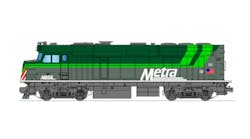Many remember late President Lyndon Johnson for succeeding President John F. Kennedy after his assassination in Dallas, Texas, on Nov. 22, 1963. Others remember him for his domestic Great Society Program, which included civil rights, Medicare, Medicaid, the War on Poverty, public broadcasting and as a friend of Israel. There was also other foreign policy, most notably the Vietnam War. Few remember his other landmark legislation: The foundation for federal financial support of public transportation.
The success of public transportation can be traced back to one of President Johnson's greatest accomplishments that continue benefiting many Americans today. On July 9, 1964, he signed the "Urban Mass Transportation Act of 1964" into law. Subsequently, this has resulted in the investment of several hundred billion dollars into public transportation. Funding was provided under grants from the Urban Mass Transportation Administration, which in 1991 became the Federal Transit Administration (FTA).
In the current federal fiscal year 2024, the FTA has made available a record $21 billion in funding under various formula and competitive discretionary programs to more than 900 transit agencies around the nation. Some of these larger formula programs include:
- $7.2 billion Section 5307 Urban Formula, including $364.9 million Section 5340 High Density States and $293.9 million Section 5340 Growing States
- $4.3 Section 5337 State of Good Repair ($4.2 billion High Intensity Fixed Guideway and $121.8 million High Intensity Motorbus);
- $630.3 million Section 5339 Bus and Bus Facilities
- $51 million Section 5307 Passenger Ferry
- $438.2 million Section 5310 Enhanced Mobility of Seniors and Individuals with Disabilities
- $938.7 million Section 5311 Rural Area Formula Program
- $343 million Division J All Stations Accessibility
One way these dollars can be used, depending upon the program, is to pay for replacement of aged buses, paratransit or commuter vans, light rail, subway, commuter rail or ferries that have reached their minimum useful life according to federal replacement eligibility criteria. They are also available for fleet expansion.
The Federal Highway Administration has funding under several programs, including Congestion Mitigation Air Quality (CMAQ), Surface Transportation Program and others that can be transferred to FTA to finance transit projects.
If you haven't already done so, apply for funding under the FTA Transit Award Management System (TrAMS). This is used by FTA to award and manage federal grants. There is still time to enter your grant(s) in TrAMS. Try to complete your grant application and answer any questions from FTA Regional Office staff as quickly as possible. This will afford FTA the opportunity to give you the green light in TrAMS, so you may formally submit your grant.
Official submission of any grant in TrAMS on or before Aug. 2 would increase your odds for success in obtaining any approved grant before the end of federal FY 24. In most cases, your grant will also be sent to the Department of Labor (DOL) for 13c certification. Without DOL 13c certification, FTA is unable to approve your grant including obligation of funding. DOL has limited staff and is usually overwhelmed with a high volume of fourth quarter grants between July and September to review. Meeting or beating the Aug. 2 date also provide the hard working FTA Regional Office staff 34 business days before Sept. 20 to award your grant(s). Remember they have families or partners, and would like to take some time off during the summer for well deserved vacations.
TrAMS usually shuts down one week before the end of September, which this year might be early the week of Sept. 23 for final obligation of pending grants. Closing down of TrAMS for grant obligations provides FTA headquarters time to balance the financial books. This is necessary in preparation for reports to Congress and Office of Management and Budget on current federal fiscal year expenditures.
In our post COVID-19 world, millions of Americans are continuing the journey back to utilize various public transportation alternatives. These include local and express bus, paratransit and commuter van, ferry, jitney, light rail, subway and commuter rail services. All of these systems use less fuel and move far more people than conventional single occupancy vehicles. Most of these systems are funded with your tax dollars thanks to President Johnson.
Depending upon where you live, consider the public transportation alternative. Try riding a local or express bus, paratransit or commuter van, ferry, light rail, commuter rail or subway. Employers offer transit checks to help subsidize a portion of the costs. Utilize your investments and reap the benefits. You'll be supporting a cleaner environment and be less stressed upon arrival.
The Metropolitan Transportation Authority (MTA) has various operating agencies, including New York City (NYC) Transit subway, bus and Staten Island Railway, Long Island Rail Road, Metro North Rail Road and MTA Bus. The ancestors to MTA Bus that operated in NYC were eight private franchised bus operators, including Queens County based Steinway Bus and Queens Transit, which combined to become Queens Surface Bus Corporation, Green Bus, Jamaica Bus and Triboro Coach, Kings County (Brooklyn) based Command Bus, previously Pioneer Bus along with Bronx based New York Bus and Liberty Lines Bronx Express. NYC between 2005 and 2006 entered into an agreement with the MTA transferring their routes and equipment to the newly created MTA Bus.
There is also New Jersey Transit, Port Authority Trans Hudson subway, NYC Department of Transportation Staten Island Ferry and NYC Economic Development Corporation private ferry program. On Long Island, there is Nassau Inter County Express, formerly Long Island Bus and before that known as Metropolitan Suburban Bus Authority, city of Long Beach bus systems, along with Suffolk County Transit Bus and Town of Huntington Area Rapid Transit Bus.
North of NYC, in the lower Hudson Valley, there is Westchester Bee Line Bus, Transport of Rockland County, Putnam Area Rapid Transit Bus, Dutchess County Loop (includes the old city of Poughkeepsie Bus) and Ulster County Bus (Includes the old city of Kingston Bus).
In upstate New York (NY), the four largest transit operators are the Niagara Frontier Transportation Authority in Buffalo, Rochester Genessee Regional Transportation Authority in Rochester, Central NY Regional Transportation Authority in Syracuse and Capital District Transit Authority in Albany. These also provide service in the surrounding suburbs.
Some of the other smaller upstate NY transit operators include Broome County Transit, Chemung County Transit, Greater Glens Fall Transit, Ontario County Transit System, Tompkins Consolidated Area Transit, City of Oneonta Public Transit Bus and Corning-Erwin Area Transit System. I could go on, but space prohibits me from acknowledging everyone.
The ability to travel from home to workplace, school, shopping, entertainment and medical is a factor when moving to a new neighborhood. Economically successful communities are not 100 percent dependent on automobiles as the sole means of mobility. Seniors, students and low and middle income people need these transportation alternatives. Investment in public transportation today contributes to economic growth, employment and a stronger economy. Dollar for dollar, it is one of the best investments we can make.
What better way to honor President Johnson and all that has been achieved these past 60 years in public transportation by continuing to fully fund the federal Highway Trust Fund and Mass Transit account.
Happy Birthday!

Larry Penner
Larry Penner is a transportation advocate, historian and writer who previously served as a former director for the Federal Transit Administration Region 2 New York Office of Operations and Program Management. This included the development, review, approval and oversight for billions in capital projects and programs for New Jersey Transit, New York Metropolitan Transportation Authority, NYC Transit bus, subway and Staten Island Railway, Long Island and Metro North railroads, MTA Bus, NYCDOT Staten Island Ferry along with 30 other transit agencies in New York and New Jersey.






